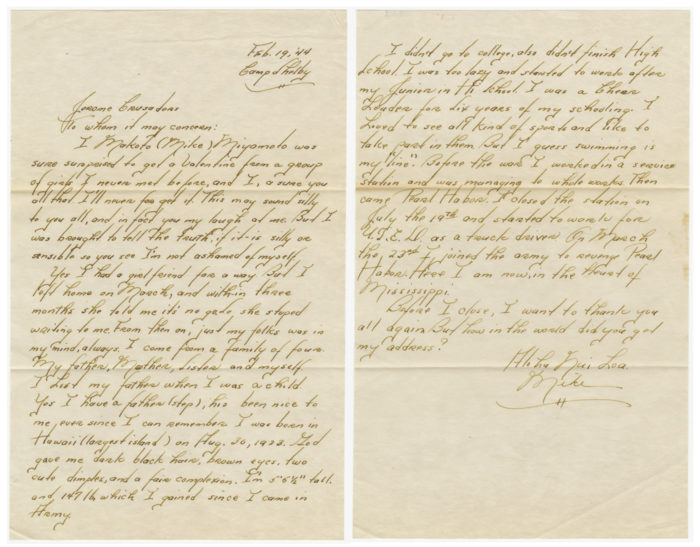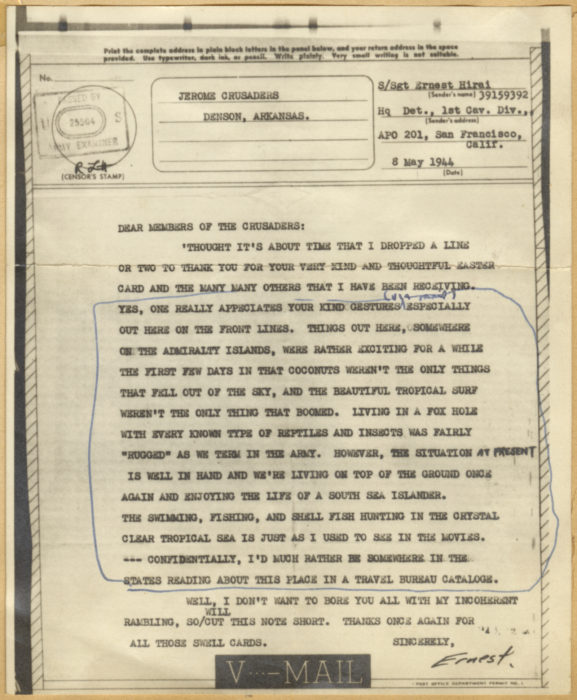Carry On, Crusaders

Japanese American National Museum, Gift of Yuri Kochiyama (94.144.1)
Click to open full-size image in new tab.Take a look at this letter from 1944.
- To whom is it addressed?
- Who sent it?
- What type of information is being shared?
- Do you think the writer knows the recipients?
While incarcerated in Jerome, Arkansas, a small group of five Sunday school students and their teacher, Mary Nakahara (who later became notable civil-rights activist Yuri Kochiyama), decided to start writing to Japanese Americans serving in the military. This effort grew as other students and parents joined in. They wrote to soldiers whose names they gathered by asking around in their community to find those with family members serving in the military. The letter-writers called themselves the Crusaders.
This page is taken from a scrapbook of letters and cards exchanged between the soldiers and the Crusaders. It was compiled and saved by Rinko Shimasaki, one of the high school students who corresponded with the soldiers.

Japanese American National Museum, Gift of Yuri Kochiyama (94.144.1)
Click to open full-size image in new tab.This is a letter to the Jerome Crusaders from Sgt. Ernest Hirai.
- What is the tone of this letter?
- By reading this letter, what can you gather about the conditions in which Sgt. Hirai is living?
- Look at the designs on the paper on which the letter is typed. What details do you notice?
- Do you see the censor’s stamp? Why would this letter need to be censored?

Japanese American National Museum, Gift of Yuri Kochiyama (96.144.1F)
Click to open full-size image in new tab.This is a page from the Crusaders’ scrapbook. Look closely at these greetings.
- To whom are they addressed?
- Who sent them?
The Crusaders expanded beyond Jerome with members in other camps as well.
- What evidence of membership in other camps can you see on this page of greeting cards?
The Crusaders were a strong network of letter writers. Despite the distance between the camps, the Crusaders shared a desire to support the soldiers in their communities and show they cared.
Yuri Kochiyama video interview (June 16, 2003), Japanese American National Museum, DiscoverNikkei.org
Click to open full-size image in new tab.In this video clip, Yuri Kochiyama talks about how a project started by a small group of young students grew rapidly to include many.
- What do you think compelled so many people to become involved?

Japanese American National Museum, Gift of Yuri Kochiyama (94.144.1)
Click to open full-size image in new tab.By writing these letters, young children and teenagers expressed support for those serving their country. Since so many had brothers, fathers, uncles, and other relatives serving in the military, others in the community got involved as well.
Mrs. Kochiyama recalls that her mother became very involved in letter writing just after her father passed away, when her mother was very lonely. Writing letters and notes to the soldiers created a sense of community among those in the camps.
As we read the correspondence, it is evident that these letters meant a great deal to the soldiers. They became a link to the community when the soldiers were far from home.
Return to Community & Culture
